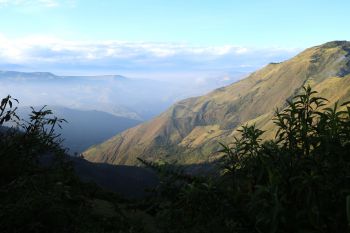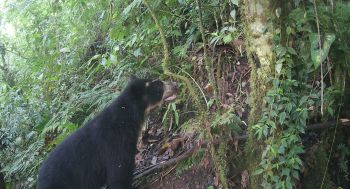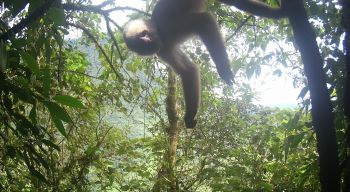Blog
Read the latest blog entries from our experts in the field.
SSRP Spotlight Series: Enhancing Equitable and Sustainable Forest Restoration in the Ecuadorian Andes
By: Edwin Gilson
Last updated: Thursday, 12 September 2024

The Ecuadorian Andes

An Andean Bear caught by the camera trap

An endangered White-Fronted Capuchin
This project was led by Professor Fiona Mathews (School of Life Sciences), with Dr Evan Killick (School of Global Studies), Dr Joanna Smallwood (School of Law, Politics and Sociology), Dr Maria-Clara Castellanos (School of Life Sciences) and Dr Alex Antonarakis (Global Studies). Fiona told us about the project.
Could you explain the background to your work in Ecuador?
My interest in Ecuador started because we go there every year with our students. We take them to an amazing reserve called Santa Lucia, which is in the Andes in Ecuador. On one trip, a wonderful local botanist from the Ecuadorian charity Fundación Cambugan kept asking me to visit the communities they work in, close to the Santa Lucia Reserve. Eventually I went with her, and was just astounded by the scale of the deforestation everywhere. This is literally just a few kilometres away from Santa Lucia, and I was left thinking, on the one hand it’s wonderful there are these protected places, but at the same time the deforestation is so shocking.
Most of the deforestation is by small-scale subsistence farmers who have moved there primarily with the intention of clearing the forest for farming. They’ve been encouraged by various government resettlement schemes to go to these areas. It’s different from some of the other projects SSRP is involved in, which are fighting against big organisations, like a big oil or mining company. These people are simply trying keep a roof over their head and put food on the table, and who dream of having enough money to send their children to college.
Initially I was in Ecuador as a conservation biologist, excited about the possibility of finding species that are new to science. But, if we don’t find a solution to the human problems underpinning deforestation, then the species aren’t going to be there for me to find.
This research builds on a previous SSRP project in Ecuador looking at vanilla cultivation which is still ongoing. The idea is to try to find alternative sustainable sources of income that might help to alleviate the pressure on the forest.
There’s a legal dimension to your current project, isn’t there?
Yes. When we were talking to people in Ecuador, one of the things they kept telling us was that they didn’t have the legal entitlement to the land they’ve settled on. They don’t have the paperwork for it. That’s common with many indigenous communities around the world. It makes life very complicated for them. So, there’s a big element of social justice about this project; we wanted to see whether having legal entitlement to the land alters the relationship people might have to it.
One of the things we quickly realised is that the local communities didn’t have access to a lot of things they needed, basic documentation like birth certificates for instance, or access to lawyers. So we’ve set up a multidisciplinary collaboration, involving Dr Evan Killick, Dr Joanna Smallwood, Dr Maria-Clara Castellanos, and Dr Alexander Antonarakis from Sussex, and also practitioners who can help people gain land titles.
We’re putting people in a position where they can actually make those legal applications. That’s what we’re gradually, gradually, edging towards. But one of the issues with granting land titles is that while it will improve social justice, it’s by no means guaranteed that that will improve conservation outcomes. So it’s important that we have long-term monitoring to see what the impacts are.
How do you tie together the social justice and conservation strands of the project?
Well, in order to gain the land title, the Environmental Ministry of Ecuador requires a formal agreement that the landowner will restore 60% of the landcover to forest. So, in theory at least, helping secure land titles for local people will have a beneficial impact on the forests of the area. The forest coverage can be monitored through satellite imagery, which will hopefully encourage conservation.
How does local wildlife factor into this?
One of the issues local communities flagged to us about was that they’re increasingly coming into conflict with Andean bears. The area we’re working in is a global biodiversity hotspot. On our last trip we also got camera trap images of an Ecuadorian White-Fronted Capuchin; it’s actually peering down into the camera. We were very excited about that. There are probably only about 500 individuals left anywhere on the planet, and they’re very averse to people.
There is still a lot of talk about road building in the area, and that would really be the end of the Capuchins. But the big issue that the local people were raising was with Andean bears, primarily because they love to eat the grain and maize, some of the really key crops in the region. The area is designated as the Andean Bear Corridor, but that designation hasn’t counted for much so far apart from to warn local people that they can’t shoot the bears.
Things have escalated recently because the local people believe that the bears are killing livestock. I’m a little unsure about whether this is true, so one of the things I did on the last trip was to leave local people swabs so we can check for the DNA of bears on any livestock that are found killed. Our camera traps have also shown quite high levels of puma activity in the region – a species local people weren’t aware of in this area - so they might be responsible.
One of the interesting aspects of working in Ecuador is that it’s one of the first countries in the world to have Rights of Nature embedded in the constitution. We’re interested in looking at how Rights of Nature Legislation is being implemented. It should translate into supporting local people to live with the bears, through conflict mitigation and measures like electric fencing and buffer zones. However, at the moment, local communities complain that this support has not been forthcoming.
What markers of progress or success are you looking out for in this project?
The camera trap images are a big one. By establishing a camera trap network we can demonstrate the presence of pumas, for instance, or the capuchins or bears. And on the Land Titles front, the critical thing is that we have already done a lot of workshops now with local people. We have sustained engagement from the local community.
We also have local lawyers who are paid to help with the paperwork. There are issues like local people not having access to a computer, or not being able to write. So we’re trying to match them up with people in the community who perhaps have a son or daughter at university and has access to IT. They can then start filing the paperwork and moving towards land titles. If we could get ten families with secure land titles over the next year or so, that would be amazing.
We’d also like to expand this concept of land title legislation and sustainable livelihoods to a bigger area, because we’re very conscious that at the moment we’re working with small numbers. To make a material difference to deforestation, it needs to involve not just ten families, but hundreds.
Is there anything else you’d like to bring up?
Just that the new Paddington movie is coming out later this year, in which Paddington goes back to Peru to look for his long-lost relatives. Paddington is an Andean bear. As far as I’m aware, the Paddington franchise hasn’t supported conservation. But obviously these bears need forests to live in.
Find out more about the project here.
This project supports the delivery of the following United Nations Sustainable Development Goals (SDGs).
SDG 1 – No Poverty
SDG 10 – Reduced Inequalities
SDG13 – Climate Action
SDG 15 – Life on Land
SDG 16 – Peace, Justice and Strong Institutions
SDG 17 – Partnerships for the Goals